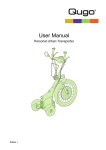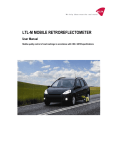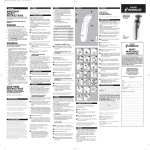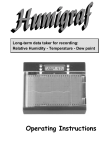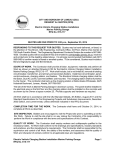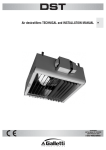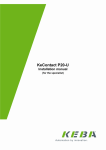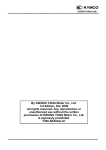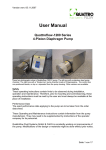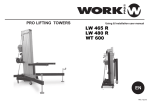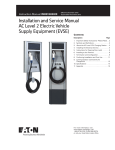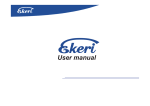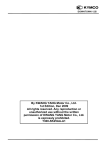Download Usermanual QU3
Transcript
Usermanual QU3 REV 12072001\01 © Urban Mobility Europe This manual or parts thereof may not be reproduced, stored in a retrieval system, or transmitted, in any form or by any means, electronic, mechanical, photocopying, recording, nor otherwise, without the prior written permission of Urban Mobility Europe. This manual could contain technical inaccuracies or typographical errors. Urban Mobility Europe reserves the right to revise this manual from time to time in the contents thereof without the obligation of Urban Mobility Europe to notify any person of such revision or change. Details and values given in this manual are average values and have been compiled with care. They are not binding, however, and Urban Mobility Europe disclaims any liability for damage or detriments suffered as a result of reliance on the information given herein or the use of vehicles, processes or equipment to which this manual refers. no warranty is made that the use of the information or of the vehicles, processes or equipment to which this manual refers will not infridge any third party’s patents or rights. The information given does not release the user from making their own experiments and tests. 2 Table of contents 1 2 3 4 About this manual......................................................................................................... 5 1.1 How to work with the manual .......................................................................................... 5 1.2 Warranty ......................................................................................................................... 5 Safety ............................................................................................................................. 7 2.1 Intended use ................................................................................................................... 7 2.2 Not intended use ............................................................................................................ 7 2.3 Liability ............................................................................................................................ 7 2.4 Safety precautions .......................................................................................................... 7 2.4.1 General................................................................................................................. 7 2.4.2 Clothing ................................................................................................................ 7 2.4.3 Driving .................................................................................................................. 8 2.5 CE certification ............................................................................................................... 8 2.6 Safety symbols on the vehicle ........................................................................................ 8 2.7 Safety symbols in the manual ......................................................................................... 9 2.8 Disposal of the vehicle .................................................................................................... 9 Installation ................................................................................................................... 11 3.1 Content ......................................................................................................................... 11 3.2 Make the vehicle ready for use ..................................................................................... 12 3.2.1 Charge the battery for the first time .................................................................... 12 3.2.2 Installation of the handle bar .............................................................................. 12 3.2.3 Installation of the mirror ...................................................................................... 13 3.2.4 Installation of the mirror ...................................................................................... 13 3.2.5 Place the saddle................................................................................................. 13 3.2.6 Remove the saddle ............................................................................................ 14 3.2.7 Place the number plate on the vehicle ............................................................... 14 3.2.8 Place the number plate on the vehicle ............................................................... 14 3.2.9 Place the number plate on the vehicle ............................................................... 15 3.2.10 Place the luggage holder(option) ....................................................................... 15 3.2.11 Tyre pressure ..................................................................................................... 15 3.2.12 Dispose of the packaging material ..................................................................... 16 3.3 Charge the battery ........................................................................................................ 17 3.3.1 Safety ................................................................................................................. 17 3.3.2 To charge the battery.......................................................................................... 17 Operator manual ......................................................................................................... 21 4.1 Description .................................................................................................................... 21 4.1.1 Overview of the vehicle ...................................................................................... 21 4.1.2 Overview of the dashboard. ............................................................................... 22 4.1.3 Type plate: details............................................................................................... 23 4.2 Driving the vehicle ........................................................................................................ 23 3 4.2.1 4.2.2 5 6 7 Safety ................................................................................................................. 23 Checks before use. ............................................................................................ 23 4.3 Step up the vehicle ....................................................................................................... 24 4.4 Cornering ...................................................................................................................... 25 4.4.1 Left corner .......................................................................................................... 25 4.4.2 Right corner........................................................................................................ 26 4.4.3 Sharp corners ..................................................................................................... 26 4.5 To brake with the vehicle .............................................................................................. 27 4.6 To park the vehicle ....................................................................................................... 28 4.7 Cruise control ............................................................................................................... 29 4.7.1 To use the cruise control .................................................................................... 29 4.8 Switch from km/h to M/h ............................................................................................... 30 Maintenance ................................................................................................................ 31 5.1 Cleaning ....................................................................................................................... 31 5.2 Maintenance ................................................................................................................. 31 5.2.1 Rearbrake........................................................................................................... 31 5.2.2 Frontbrake .......................................................................................................... 32 5.2.3 Adjust the handle bar levers ............................................................................... 32 Troubleshooting.......................................................................................................... 33 6.1 General troubleshooting procedure .............................................................................. 33 6.2 Contact service ............................................................................................................. 33 6.3 Troubleshooting guide .................................................................................................. 33 Technical data ............................................................................................................. 35 7.1 General specifications .................................................................................................. 35 4 About this manual 1 About this manual The manual shows the information necessary to: - install - operate - perform basic maintenance - correct small problems The Qugo and all its versions are referred to in the manual as the ’vehicle’. This manual describes both types A (25 km/h) and type B (33 km/h) of the vehicle. This manual contains the original instructions. The original language of the manual is English. 1.1 How to work with the manual 1. Familiarize yourself with the structure and content. 2. Read the safety chapter in detail and make sure you understand all the instructions. See § 2. 3. Carry out the actions completely and in the given sequence. 1.2 Warranty Nog aan te leveren text 5 About this manual 6 Safety 2 Safety WARNING Read the manual before you install or use the vehicle. Failure to do so can result in personal injury, death or property damage. 2.1 Intended use The vehicle is designed to transport a single person. Any other use of the vehicle is strictly forbidden. 2.2 Not intended use Do not use the vehicle for mountain riding, speed riding, downhill riding and stunt riding. 2.3 Liability Urban Mobility Europe is not liable is you do not follow the rules below: - Do not use a damaged vehicle. When you have doubts, contact your supplier or the service department of Urban Mobility Europe See www.Qugo.nl. - Install and connect the vehicle according to the instructions in this manual. - Observe all local safety regulations. - Obey the local regulations concerning traffic laws and personal protection equipment.. - Connect the vehicle to an earthed wall socket. - Keep the vehicle in good condition. Make sure that defective parts are immediately replaced. - Replace parts only with original Urban Mobility Europe spare parts. All maintenance beyond the scope of this manual must be carried out by a local Qugo dealer that Urban Mobility Europe has trained and certified. 2.4 Safety precautions 2.4.1 General - Practice in a safe area before you use the vehicle in traffic. - Make sure that you know the structure and the contents of the manual. - Do the procedures of the manual fully and in the given sequence. - Keep body parts away from the spinning wheels. - Guarantee will void when the procedures in the manual are not done fully. 2.4.2 Clothing - Wear a helmet when you use the vehicle. - Keep clothing away from the spinning wheels. - Wear proper shoes when you use the vehicle. 7 Safety - Wear visible clothing when you use the vehicle - Do not wear loose clothes that can come into moving parts. 2.4.3 Driving - Drive carefully when the road is wet. - Drive carefully when the road is covered with loose dirt or gravel. - Do the procedures of the manual fully and in the given sequence. 2.5 CE certification The vehicle is CE certified and approved according to european regulations (RWE 2002/24/ EC. It means that the vehicle complies with the essential requirements concerning safety. The directives that have been taken into consideration in the design are available on www.Qugo.nl 2.6 Safety symbols on the vehicle www.qugo.nl /i Refer to the manual before use www.qugo.nl High Voltage 8 Safety 2.7 Safety symbols in the manual /i WARNING Note Can cause personal injury. Shows further information. CAUTION Can cause damage to the vehicle. 2.8 Disposal of the vehicle 1. Sort the vehicle, the accessories and the packaging for environmentally friendly recycling. 2. Do not dispose of the vehicle into domestic waste. Dispose of the vehicle according to local regulations. 9 Safety 10 Installation 3 Installation 3.1 Content www.qugo.nl B G Optional C D E A A: B: C: D: E: F: G: Qugo Quick reference guide Battery charger Saddle Number plate holder Mirror (Left or right) Luggage holder 11 F Installation 3.2 Make the vehicle ready for use 3.2.1 Charge the battery for the first time 1. Connect the battery charger (A) to charging point (B). See § 3.3.2. 2. Charge the battery for 24 hours. B 24hr CAUTION Avoid contact with water when you charge the vehicle. A 3.2.2 Installation of the handle bar 1. Lift up the handle bar (A). 2. Tighten the levers (B) of the handle bar. A WARNING Make sure the levers are fixed tight on to the vehicle. 12 B Installation 3.2.3 Installation of the mirror 1. Place the mirror (A) with a clamp ring on the left hand side of the handle bar (B) and fix it with a bolt. 4 Note A For countries driving at the right hand side of the road B 3.2.4 Installation of the mirror 1. Place the mirror (A) with a clamp ring on the right hand side of the handle bar (B) and fix it with a bolt. 4 Note For countries driving at the left hand side of the road B 3.2.5 A Place the saddle 1. 2. 3. 4. 5. Remove cap (B). Place the saddle (A). Remove cap (C). Tighten the saddle adjustment with an allen key. Place back cap (C). 4 4 A B WARNING Make sure the saddle if fixed firmly on to the vehicle. 13 C Installation 3.2.6 Remove the saddle 1. 2. 3. 4. Remove cap (C). Loosen the saddle adjustment with an allen key. Remove saddle (A). Place the cap (B). 5. Place back cap (C). 4 A B C 3.2.7 Place the number plate on the vehicle Clean the spot where you want to fo place the nuber plate holder with alcohol. 2. Remove the protection foil (A) from the the double sided tape. 3. Fix the number plate holder (B) onto the left hand side fender. 4. Fix the number plate (C) with the screws onto the number plate holder. 1. A C B Note For countries driving at the right hand side of the road 3.2.8 Place the number plate on the vehicle Clean the spot where you want to fo place the nuber plate holder with alcohol. 2. Remove the protection foil (A) from the the double sided tape. 3. Fix the number plate holder (B) onto the left hand side fender. 4. Fix the number plate (C) with the screws onto the number plate holder. 1. Note For countries driving at the left hand side of the road 14 A C B Installation 3.2.9 Place the number plate on the vehicle 1. PLace the number plate (A) at the back of the vehicle with screws (B). A B 3.2.10 Place the luggage holder(option) 1. Fix the luggage holder (A) onto the handle bar with screw (B). A WARNING maximum load weight is 5 Kg. 3 B 3.2.11 Tyre pressure 1. Make sure the tyre pressure ot the tyres is correct. CAUTION Check the tyre pressure of the rear tyre on a regular basis. 0 bar 15 3,5 bar 50 psi 15 0 bar 15 2,5 bar 36 psi Installation CAUTION Do not exceed the tyre pressure given in the drawing. 3.2.12 Dispose of the packaging material 1. Dispose of the packaging material in an environmentally friendly way, according to local regulations. 16 Installation 3.3 Charge the battery 3.3.1 Safety - Keep your battery charged. Do not drop the battery. Do not short circuit the battery. Charge the battery in a dry and open well ventilated aera. Charge the battery at least once a month. Only adults must charge the battery Do not expose the battery to heat or direct sunlight. 3.3.2 To charge the battery To charge 1. Turn the parking brake (A) up. 2. Make sure the brake (B) is in. B A 3. Remove key (A) from contact (B). A B 17 Installation 4. Connect the battery charger (A) to the charging point (B) of the vehicle. B Note First connect the battery charger to the vehicle. A 5. Connect the battery charger (B) to the wall socket (A). B Note Make sure your battery is always charged. 6. Stop charge the battery if the indicator indicates the battery is full. 18 A Installation 7. Disconnect the battery charger from the vehicle 8. Disconnect the battery charger from the wall socket 9. Place back the plug (A) in to the charge point (B) of the vehicle. CAUTION The caps prevent corrosion on the charge point. 19 B A Installation 20 Operator manual 4 Operator manual 4.1 Description 4.1.1 Overview of the vehicle K L A M B N C O D P E F G H I J Q R A: B: C: D: E: F: G: H: I: Mirror (Left or right) Luggage holder (Option) Handle bar levers Saddle Chargepoint Rear light Reflector Number plate holder Batteryholder 21 J: K: L: M: N: O: P: Q: R: Number plate holder Front brake Dashboard Rear brake Parking brake Headlight Motor Torque reaction arm Rotation coupling device Operator manual 4.1.2 Overview of the dashboard. Stop Go Stop K J I A A: B: C: D: E: F: G: H: I: J: K: B C D Cruise control (Switch from Km/h to M/h) Horn Left indicator (not connected) Light indicator ON indicator Right indicator (not connected) Contactswitch Light switch Throttle control Front brake Rear brake 22 E F G H Operator manual 4.1.3 Type plate: details A B C D Compagny name Ce Markking VIN (Vehicle Industrial name) Sationary sound level A Note At the bottom of the frame the chassisnumer is found. B C D 4.2 Driving the vehicle 4.2.1 Safety - 4.2.2 Obey the local regulations concerning traffic laws and personal protection equipment. Do not ride trough heavy rain. Do not ride trough deep puddles. Do not ride on steep hills Do not lift the vehicle at the front end. Checks before use. - Make sure that the battery is charged completely Make sure the saddle adjusting mechanism is thightened. Make sure you do a check on the vehicle on mechanical or electrical parts. 23 Operator manual 4.3 Step up the vehicle 1. Make sure the tyre pressure is ok CAUTION Check the tyre pressure of the rear ttyres on a regular basis. 0 bar 15 3,5 bar 50 psi 0 bar 15 2,5 bar 36 psi 2. Turn the parking brake (A) down. 3. Make sure the front and rear brake (B) is out. CAUTION Do not drive with the parking brake. it causes damage to your vehicle. B A 4. Put the key (A) into the contact (B). A B 24 Operator manual 5. Pull the handle bar (A) and step up the vehicle. A 6. Release the brakes (A) 7. Lean slighly towards the handle bar. 8. Push the lever (B) forward to accelerate. A B 4.4 Cornering 4.4.1 Left corner 1. Push your right heel down to make a left corner. Note Stretch the right leg ease the inner foot and bend left knee 25 Operator manual 4.4.2 Right corner 1. Push your left heel down to make a right corner. Note Stretch the left leg ease the inner foot and bend right knee 4.4.3 Sharp corners 1. Make sure that the lowest point of the vehicle do not touch the road when you make a sharp corner. 26 Operator manual 4.5 To brake with the vehicle 1. Release the Throttle control (A). 2. Control the brake(B) with care. A Note Use both brake for adequate stopping power B 3. Make sure that you control the brakes too firmly to prevent the vehicle to tip over. WARNING Avoid to brake hard and sudden. 27 Operator manual 4.6 To park the vehicle 1. Remove key (A) from contact (B). A B 2. Turn the parking brake (A) up. 3. Make sure the brake (B) is in. B 4. Fix the vehicle to a fixed poin with a chainlock. Note Place the chain so, that the chainlock can not damage the vehicle. 28 A Operator manual 5. Place Cap (A), (B) and (C). Note A The caps prevent the water enters the frame. B CAUTION Water causes serious damage to the electrical system of the vehicle. C 4.7 Cruise control 4.7.1 To use the cruise control 1. Push the cruise control button (A) to activate the cruise control. 2. Push the cruise control button (A) again to de activate the cruise control Note The Cruise control is de-activated automatically when you activate the brake. A 29 Operator manual 4.8 Switch from km/h to M/h 1. Keep the cruise control button for 10 sec to switch from Kilometers to Miles. A 30 Maintenance 5 Maintenance 5.1 Cleaning 1. Clean the vehicle with a sponge and luke warm water. CAUTION Do not use a high pressure hose . CAUTION Avoid that water comes into contact with the electical system trough openings in the frame . Water causes serious damage to the electrical system of the vehicle. 5.2 Maintenance 5.2.1 Rearbrake 1. Loosen lock nut (B). 2. Turn knob (A) tighter to adjust te brake. 3. Tighten locknut (B). A B 31 Maintenance 5.2.2 Frontbrake 1. Loosen lock nut (B). 2. Turn knob (A) tighter to adjust te brake. 3. Tighten locknut (B). A B 5.2.3 Adjust the handle bar levers 1. Tip over lever (A) and lever (B). 2. Turn the lever clockwise or anticlockwise to adjust the lever. 3. Move back lever ( and lever (B) 4. Start with step 1 if the lever (A) or( B) can not move completely to the handle bar or when the handle bar is not firmly tightened. Note Do not screw in the lever (A) or (B) too far in. A B 32 Troubleshooting 6 Troubleshooting 6.1 General troubleshooting procedure 1. Try to solve the problem with the information in this manual. See § 6.3. 2. If it is not possible to solve the problem with the information in this manual, contact service. See § 6.2. 6.2 Contact service 1. Contact your supplier or manufacturer. See www.qugo.nl 6.3 Troubleshooting guide Problem Possible cause Possible solution Battery level indicator indicates one block vehicle is used too long Recharge the battery battery is not charged fuly Contact service. See § 6.2. Overload protection Turn of the power with the contact key. vehicle does not drive smoothly Battery level too low Charge your battery Rear brake does not function properly Brake adjustment not correct. See § 5.2.1 Front brake does not function properly Brake adjustment not correct See § 5.2.2 Handle bar too loose handle bar levers adjustment not correct See § 5.2.3 Front light is broken Contact your local dealer Rear light is broken Contact your local dealer 33 Troubleshooting 34 Technical data 7 Technical data 7.1 General specifications /i Parameter Specification Maximum load weight [kg] 40 Dimensions, height x width x depth [cm] 108x86x75 Packed dimensions, height x width x depth [cm] 126x97x80 Net mass [kg] 171 Packed mass [kg] 200.5 Temperature [°C] +5 to +40 Altitude above sea level [m], out of operation -10 to 12000 35 Technical data 36




































